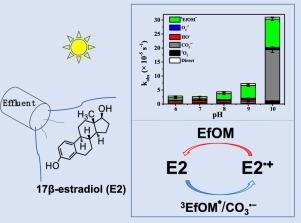Water Research ( IF 12.8 ) Pub Date : 2020-11-11 , DOI: 10.1016/j.watres.2020.116633 Lushi Lian , Chenyong Miao , Zhenyu Hao , Qian Liu , Yingjie Liu , Weihua Song , Shuwen Yan

|
Photodegradation of the natural steroid 17β-estradiol (E2), an endocrine-disrupting hormone that has been widely detected in aquatic environments, was investigated in wastewater effluents at various pH ranges under simulated solar irradiation. The rate of E2 degradation in the sewage effluents was stable at pH 6.0-7.0 but suddenly increased from pH 8.0-10.0. The second-order reaction rate constants of E2 with 3EfOM* and CO3•− were measured to increase 11.0-fold and 18.0-fold from pH 6.0 to 10.0, respectively. Two main reasons are proposed for this sharp increase. First, the change in the ionization state of E2 made it susceptible to oxidation by triplet-state effluent organic matter (3EfOM*) and carbonate radicals (CO3•−). Second, the steady-state concentration of CO3•− increased with increasing pH. Indirect photolysis was suggested to be the main degradation pathway in the sewage effluents, and 3EfOM* was proposed to play a major role at pH 8.0-9.0, while CO3•− played a significant role at pH 10.0. In this study, EfOM was shown for the first time to inhibit the oxidation of E2 initiated by 3EfOM* and CO3•−. Thus, we suggest that EfOM plays a dual role in the photodegradation of E2: EfOM can not only be activated as 3EfOM* to degrade E2 but also can inhibit the degradation of E2 by reducing the E2 oxidation intermediate back to E2. The estrogenic activity of the photodegradation products was also studied. The in vitro estrogenic activity of E2 solutions decreased approximately as fast as the E2 photodegradation occurred in the effluent water at various pH values, suggesting that solar photodegradation in sewage effluents reduces the risk of endocrine disruption in waters impacted by E2 and subject to continuing inputs. The results of this study are important for predicting the environmental fate of endocrine-disrupting chemicals and developing methods for their removal from aquatic environments.
中文翻译:

重新评估反应性中间体对污水中17β-雌二醇光化学转化的贡献
在模拟太阳辐射下,在各种pH范围的废水中,研究了在水生环境中广泛检测到的天然甾体17β-雌二醇(E2)的内分泌干扰激素的光降解作用。在pH 6.0-7.0下,污水中E2的降解速率稳定,但从pH 8.0-10.0突然增加。测量E2与3 EfOM *和CO 3 •-的二阶反应速率常数,从pH 6.0到10.0分别增加11.0倍和18.0倍。提出了导致这种急剧增加的两个主要原因。首先,E2的电离状态的变化使其易受三重态流出物有机物(3 EfOM *)和碳酸盐自由基(CO 3 •−)。其次,CO 3 •的稳态浓度随pH值的增加而增加。间接光解被认为是污水中的主要降解途径,有人提出3 EfOM *在pH 8.0-9.0时起主要作用,而CO 3 •在pH 10.0时起重要作用。在这项研究中,首次显示EfOM抑制3 EfOM *和CO 3 •−引发的E2氧化。因此,我们建议EfOM在E2的光降解中起双重作用:EfOM不仅可以激活为3EfOM *可以降解E2,但也可以通过将E2氧化中间体还原回E2来抑制E2的降解。还研究了光降解产物的雌激素活性。在各种pH值下,废水中E2溶液的体外雌激素活性下降速度与E2降解速度几乎一样快,这表明污水中的太阳光降解降低了受E2影响并需持续投入的水中内分泌破坏的风险。这项研究的结果对于预测破坏内分泌的化学物质的环境命运以及开发将其从水生环境中清除的方法具有重要意义。


























 京公网安备 11010802027423号
京公网安备 11010802027423号